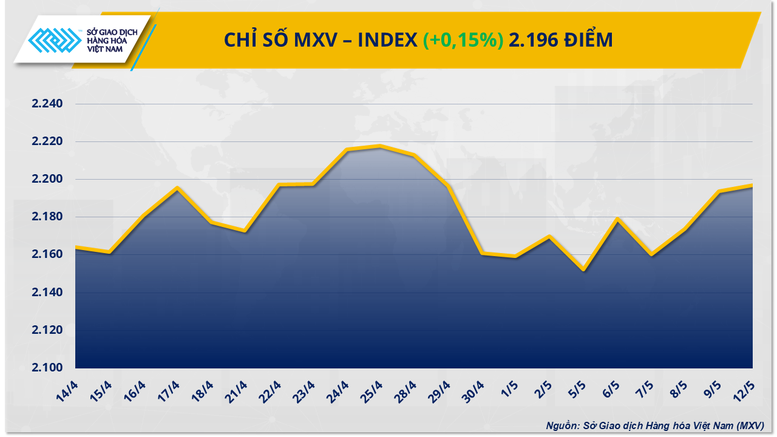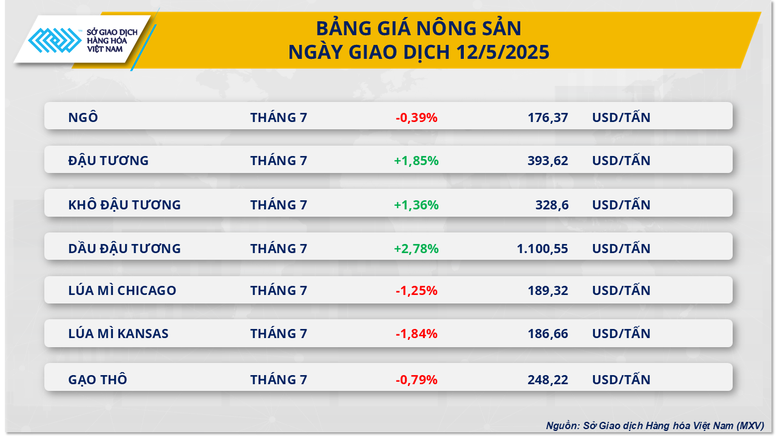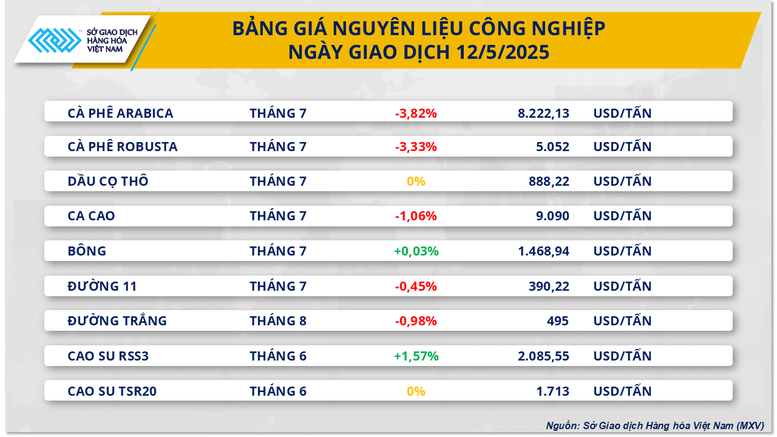
Soybean market benefits from talks
According to MXV, the agricultural market reacted quickly to the results of the tariff negotiations. In particular, soybean prices jumped sharply by 1.85% to 393 USD/ton in yesterday's session. Notably, two finished products, soybean meal and soybean oil, also increased sharply, respectively by 1.36% to 328 USD/ton and 2.78% to 1,100 USD/ton.
The market focus yesterday was on the outcome of the negotiations between the US and China that took place on May 10 in Geneva, Switzerland. After months of trade tensions, the agreement of the world’s two largest economies to reduce import tariffs for 90 days fueled optimism in the market.

According to the official announcement, the two largest economies have reached an agreement to reduce tariffs on imported goods from the other country. Currently, the US tariff on goods from China has been reduced from 145% to 30%; for China, the reduction is from 125% to 10%. This is a significant reduction, opening up great expectations for agricultural exports, especially soybeans, in the coming time.
The upward momentum in soybean prices was further reinforced after the US Department of Agriculture (USDA) released its May WASDE report with a series of positive figures. Accordingly, the old crop ending inventory decreased to more than 9.53 million tons, lower than market expectations, while the new crop inventory started at more than 8.03 million tons, down 16% compared to the previous year and significantly lower than the average forecast of analysts. Instead of sharply adjusting down exports as previously feared, USDA only slightly lowered the export forecast to 952,500 tons, while oil crushing consumption was raised by 1.9 million tons, reflecting a positive domestic consumption outlook. At the same time, the average selling price expected by farmers was also adjusted up by 30 cents, to $376.63/ton for the new crop.
Globally, USDA continues to see Brazil's soybean output reach a record high of 175 million tons in the 2025-2026 crop year, cementing its position as the world's leading exporter. At the same time, China's soybean imports are forecast to increase to 112 million tons, reflecting strong demand in this market. However, USDA forecasts global soybean inventories to increase to 124.33 million tons, indicating that supply remains abundant and is a factor that needs to be monitored. Notably, China is accelerating its roadmap to reduce the use of soybean meal in animal feed, with the goal of reducing it to below 13% by 2025 and only 10% by 2030. This trend could reduce China's soybean import pressure in the coming crop years, thereby affecting the global supply-demand balance.
For the two finished products, soybean oil prices led the trend of the whole group when they increased sharply by 2.78% in the last session. This increase was mainly due to the information that the 45Z tax credit package for biofuels in the US is likely to be extended until 2031, thereby continuing to boost the demand for soybean oil as a feedstock for biodiesel production.

Contrary to the general market trend, the industrial raw material group experienced a less positive trading session when most of the key commodities in the group decreased in price. Of which, the price of Arabica coffee lost nearly 4% to 8,222 USD/ton, the price of Robusta coffee also decreased by more than 3% to 5,052 USD/ton.
According to MXV, coffee prices were under strong downward pressure in the last session, mainly due to the soaring USD after the US-China trade agreement, along with the prospect of continued positive supply.
Source: https://baochinhphu.vn/sau-cuoc-dam-phan-my-trung-tam-ly-lac-quan-lan-toa-thi-truong-hang-hoa-the-gioi-102250513092825594.htm




![[Photo] Prime Minister Pham Minh Chinh chairs a meeting on the implementation of the Lao Cai-Hanoi-Hai Phong railway project.](https://vphoto.vietnam.vn/thumb/1200x675/vietnam/resource/IMAGE/2025/5/20/0fa4c9864f63456ebc0eb504c09c7e26)

























































































Comment (0)